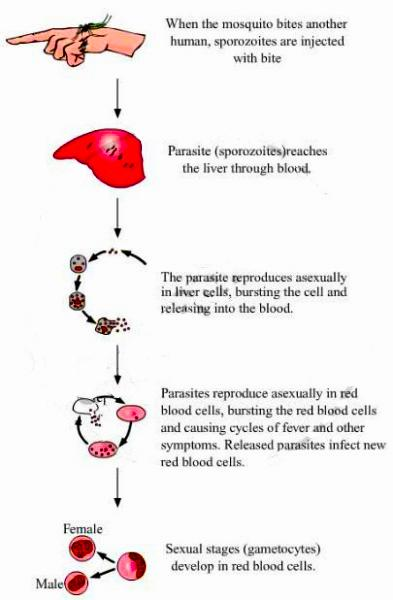
Assertion:
There is no chance of malaria to a man on the bite of a male Anopheles mosquito.
Reason:
It carries a nonvirulent strain of plasmodium
A. Both assertion and reason are correct and the reason is a true explanation for assertion
B. Both assertion and reason are correct but the reason is not the correct explanation for the assertion.
C. Assertion is correct but the reason is incorrect
D. Both assertion and reason are incorrect
Answer
555.3k+ views
Hint:Malaria has been for thousands of years a very serious disease of the tropical and temperate regions. Malaria is caused by the toxins produced in the human body by the malarial parasite, Plasmodium. The attack of malaria is preceded by yawing, tiredness, headache, and muscular pain.
Complete answer:1. The malarial parasites are carried from the infected to healthy persons by female Anopheles mosquito.
2. The mosquito picks up the parasites with the blood when it bites an infected person.
When this infected mosquito bites a healthy person, parasites migrate into his blood with the saliva, which the mosquito injects before sucking blood to prevent its clotting.
3. The malarial parasite, plasmodium enters the human body as sporozoites (infectious form) through the bite of an infected female Anopheles mosquito.
4. The sporozoites reach the liver cells via blood where they initially multiply. These then attack the red blood cells resulting in the rupturing
5. The rupture of RBCs is associated with the release of Hemozoin, a toxin that causes the chill and high recurring fever every three to four days. When a female Anopheles mosquito bites an infected human being, the malarial parasite enters into the mosquito’s body and undergoes further development.
6. They multiply to form sporozoites that finally move to the salivary glands of the insect.
When these mosquitoes bite a human, the sporozoites are introduced in his/her blood, initiating the cycle again.

So the correct answer is option C. Assertion is correct but the reason is incorrect.
Note: Malaria is caused by a microorganism which is plasmodium. Plasmodium completes its life cycle in two phases and two hosts: asexual phase in the human host and sexual phase in the female Anopheles mosquito host.
Complete answer:1. The malarial parasites are carried from the infected to healthy persons by female Anopheles mosquito.
2. The mosquito picks up the parasites with the blood when it bites an infected person.
When this infected mosquito bites a healthy person, parasites migrate into his blood with the saliva, which the mosquito injects before sucking blood to prevent its clotting.
3. The malarial parasite, plasmodium enters the human body as sporozoites (infectious form) through the bite of an infected female Anopheles mosquito.
4. The sporozoites reach the liver cells via blood where they initially multiply. These then attack the red blood cells resulting in the rupturing
5. The rupture of RBCs is associated with the release of Hemozoin, a toxin that causes the chill and high recurring fever every three to four days. When a female Anopheles mosquito bites an infected human being, the malarial parasite enters into the mosquito’s body and undergoes further development.
6. They multiply to form sporozoites that finally move to the salivary glands of the insect.
When these mosquitoes bite a human, the sporozoites are introduced in his/her blood, initiating the cycle again.

So the correct answer is option C. Assertion is correct but the reason is incorrect.
Note: Malaria is caused by a microorganism which is plasmodium. Plasmodium completes its life cycle in two phases and two hosts: asexual phase in the human host and sexual phase in the female Anopheles mosquito host.
Recently Updated Pages
Master Class 12 Business Studies: Engaging Questions & Answers for Success

Master Class 12 Economics: Engaging Questions & Answers for Success

Master Class 12 English: Engaging Questions & Answers for Success

Master Class 12 Maths: Engaging Questions & Answers for Success

Master Class 12 Social Science: Engaging Questions & Answers for Success

Master Class 12 Chemistry: Engaging Questions & Answers for Success

Trending doubts
What are the major means of transport Explain each class 12 social science CBSE

Which are the Top 10 Largest Countries of the World?

Draw a labelled sketch of the human eye class 12 physics CBSE

Explain sex determination in humans with line diag class 12 biology CBSE

The pH of the pancreatic juice is A 64 B 86 C 120 D class 12 biology CBSE

Give 10 examples of unisexual and bisexual flowers




